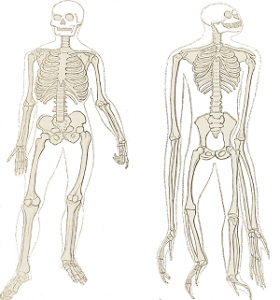
This handout can be used in discussions on the evolution of bipedalism or in any unit on the skeletal system. Students label the bones of the skeleton and make comparisons between the forelimbs, hind limbs, and pelvis.
I created this handout to compliment an evolutionary lesson and video from HHMI on the “Origin of Humans” which includes a video that explains how bipedalism evolved.
Anatomy students could also benefit from examining how structure relates to function, noting how the forelimbs of humans are shorter and the pelvis is more bowl-shaped to allow for an upright walking position.
Directions are intentionally left vague to adjust for varying levels of difficulty. Students can label all of the bones or only a few bones, though I suggest using this handout as a way to discuss human evolution and how we are similar to non-human primates.
Grade Level: 9-12
Time Required: 30-45 minutes
HS-LS1-2 Develop and use a model to illustrate the hierarchical organization of interacting systems that provide specific functions within multicellular organisms
HS-LS4-3 – Apply concepts of statistics and probability to support explanations that organisms with an advantageous heritable trait tend to increase in proportion to organisms lacking this trait.

